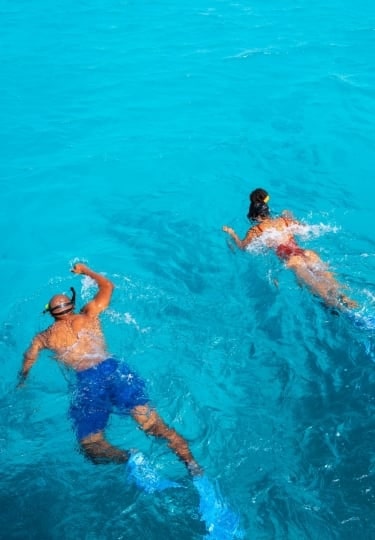Sue Bryant Author’s Note: I love the ABC islands; they’re completely different from the rest of the Caribbean with their desert-like landscapes. If you love snorkeling and want a different scene from the busier islands, Bonaire is the dream.
Situated off the coast of South America, Bonaire is the “B” in the ABC Islands; neighbors Aruba and Curaçao are the other two. Though it’s technically part of the Netherlands—a special municipality, to be exact—it has a tropical feeling that’s unmistakably unique to the Caribbean. Despite its small size, there are plenty of exciting things to do in Bonaire.
The island is well known for its status as one of the best scuba diving locations in the world, with nearly 90 dives accessible right off the island’s shores. Learning to scuba dive is one of the best things to do here because the dropoffs are shallow, the water is clear, and the currents are usually minimal. With so many professional dive shops and such a huge variety of wildlife to see around the island’s well-protected reefs, this is the place to try diving if you think there’s even the tiniest chance you’ll enjoy it.
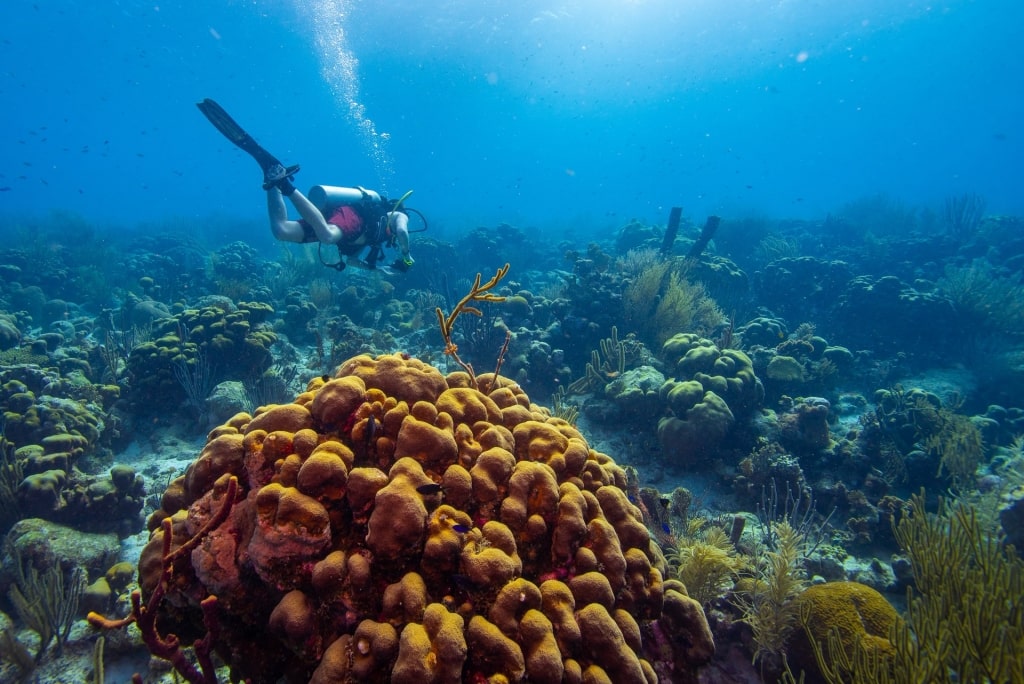
Beautiful reefs of Bonaire
Not ready to strap on a tank? No problem. You can still get up close and personal with massive angelfish, bannerfish, spotted manta rays, Spanish lobsters, seahorses, sea turtles, octopuses, and so much more by snorkeling or signing up for a kayak tour.
If you prefer to stay on land, you can tour historic sites, ATV through the desert terrain, spot neon pink flamingos at a preserve, or spend the afternoon sitting in the shade of a palm tree while you sample the world’s only cactus-based liquor.
Read on for a not-at-all exhaustive list of all the relaxing, adventurous, and bucket-list things to do in Bonaire.
Dive In at the Bonaire National Marine Park
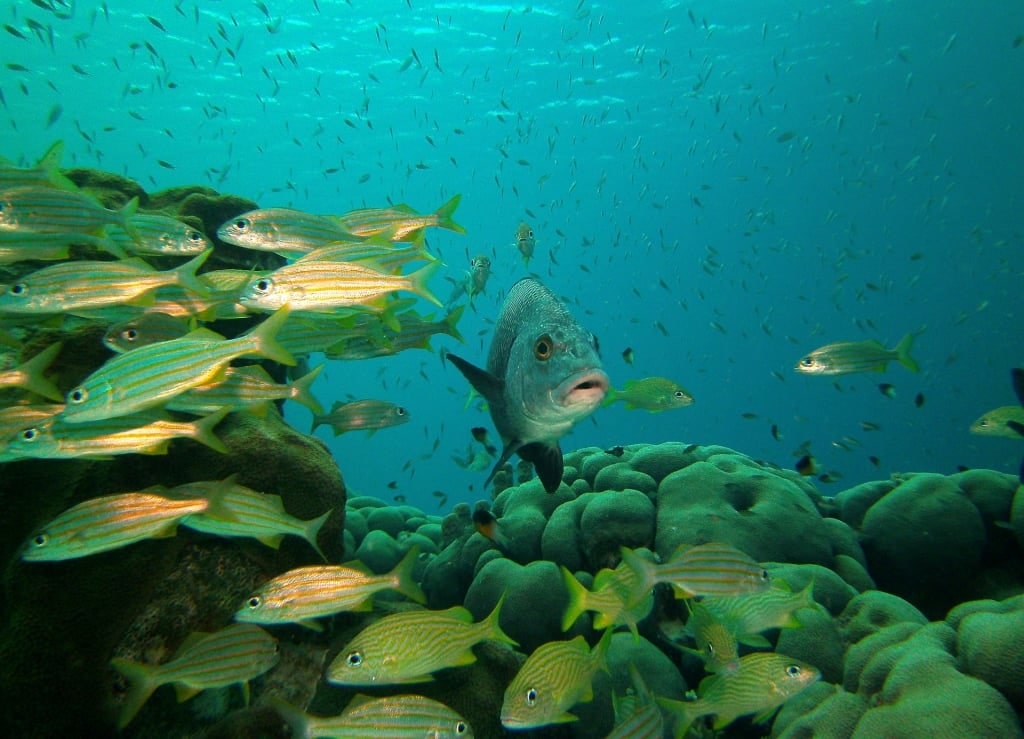
Bonaire National Marine Park
Bonaire draws divers from around the world each year who prefer to shore dive. Rather than having to take a boat to your dive site, shore diving allows you to simply get your gear ready on the sand and swim out to the dive site.
Even if you’ve never touched a scuba tank, you can still get in the water in the Bonaire National Marine Park. One of the best places to go diving in Bonaire, it covers nearly 6,700 ocean acres. You’ll dive in shallow, protected water under the guidance of a certified instructor who will teach you everything you need to know to be a safe first-time diver.
If you spend time in the water in Bonaire (which you definitely should,) consider bringing a waterproof GoPro or a waterproof camera case for your phone. More than 350 species of fish and 50 species of coral call the marine park home. The reefs here are so healthy and lively that it was added to the UNESCO list of World Heritage Biodiversity sites in 2011.
Snorkel off a Picturesque Beach
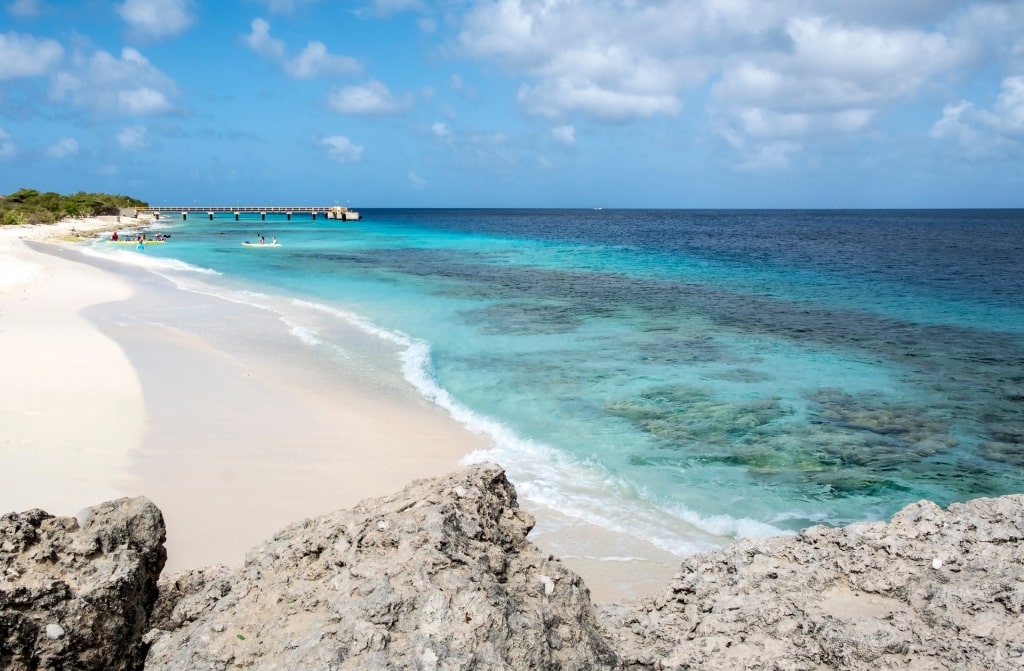
Te Amo Beach
If dreaming of the Caribbean brings to mind thoughts of white, sandy beaches, you’re in luck: Te Amo (I Love You) Beach is just that. Frequently cited as one of the Caribbean’s best beaches, this spacious public beach has a very gentle drop off, so it’s ideal for kids and families who prefer protected shallow water.
That geography also makes it one of the best islands for snorkeling in the Caribbean. Because the water is clear and relatively shallow near the shore, you can float just a few feet above colorful bannerfish, angelfish, and blue-striped sergeant majors. Snorkel gear rentals are available nearby, and there’s usually at least one food truck available if you work up an appetite. The beach occasionally plays home to sea turtle nests; be sure to give the turtles and eggs plenty of space if you’re lucky enough to come across one.
Tour a Mangrove Forest in Lac Bay National Park
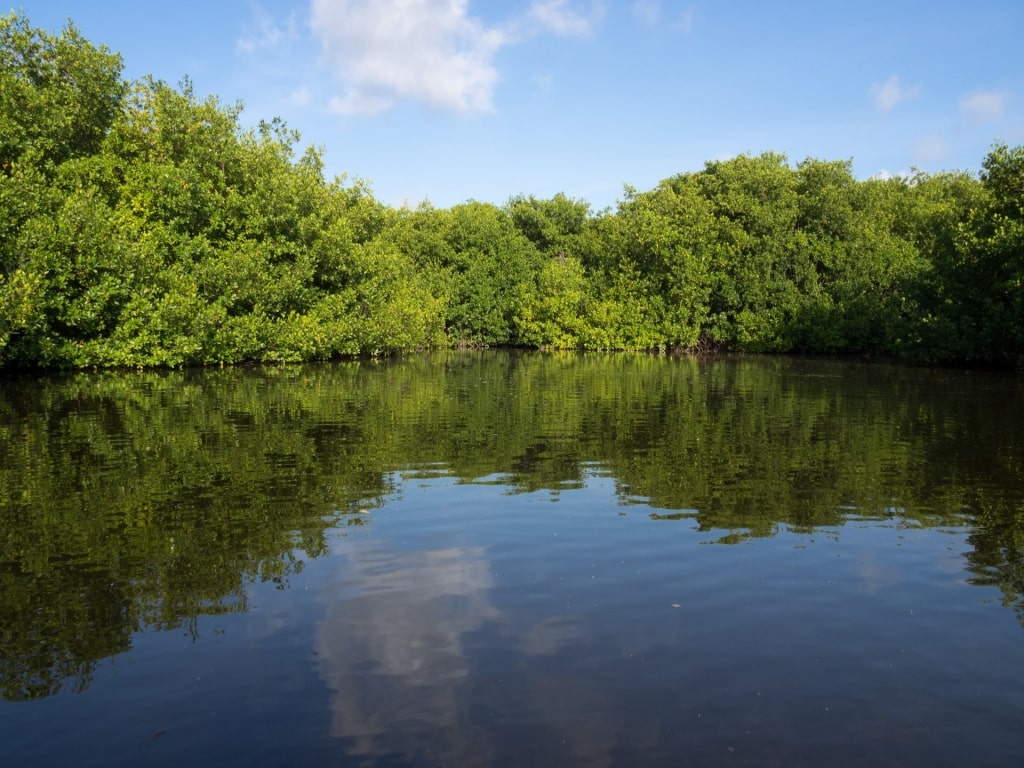
Lac Bay National Park
If you’d rather be on the water than in the water, plan to visit the mangrove forest in Lac Bay National Park. Things to do in Bonaire aren’t just limited to snorkeling and diving, and here, you can slowly meander through the protected mangrove forest, where intricate root formations and bright green trees hover just inches above the water’s surface. You’ll often see conchs, sea birds, lobsters, shellfish, and the occasional baby manta ray darting around in the surprisingly clear water.
There are a few different ways to tour the forest. If you prefer to take it easy and enjoy your surroundings, opt for a tour on an electric-powered inflatable boat. If you’d like to take a more active role in navigation, you can go on a kayak tour and paddle through the canals and mangrove tunnels. The area is protected and usually free of currents, so it’s completely doable even if you’re an inexperienced paddler.
Stroll the Beach at Willemstoren Lighthouse
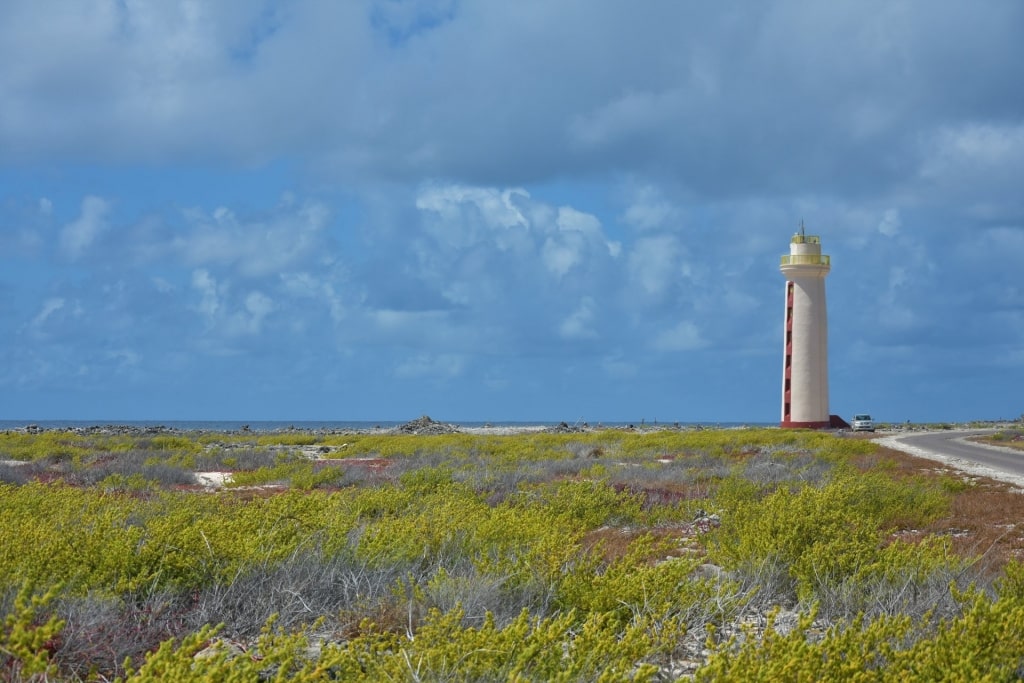
Willemstoren Lighthouse
As you might imagine from a small island surrounded by reefs, Bonaire has several lighthouses, most of which were built in the early to mid-1800s. While they once saved ships from beaching themselves on the shallow reefs, they now mostly serve as historical sites and meeting places for social events.
Willemstoren Lighthouse is on the south end of the island, and while it’s small, it’s quite lovely—the bright pink, red, and yellow colors make for excellent photos, especially on the odd chance a storm is coming in.
Winds are usually a bit stronger on this side of the island, making it a popular spot for beachcombing. You’ll often see unusual sculptures on the beach created by locals out of driftwood and other found materials from the sea.
Visit Bonaire’s Little Sibling
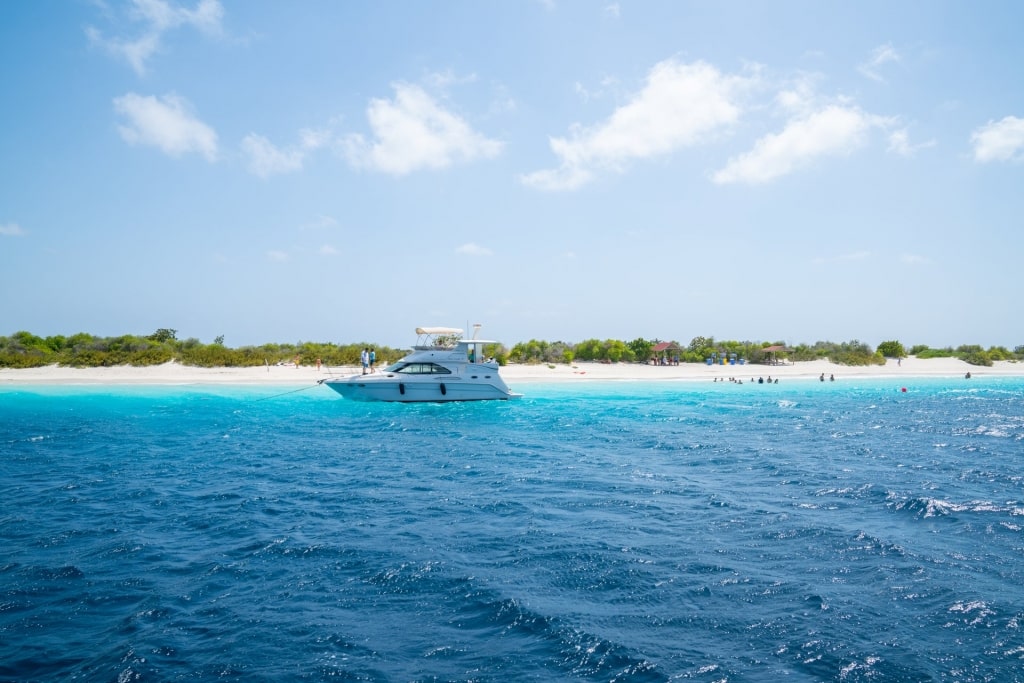
Klein Bonaire
When you arrive in Bonaire, one of the first things you’ll notice is the small island just off the coast of Kralendijk called Klein Bonaire. This hidden gem in the Caribbean is uninhabited, so it’s only available for day trips. To get there, you can take a water taxi from Kralendijk—but for a much more fun experience, consider setting sail to the island on a traditional junk ship.

Junk Boat
Once on Klein Bonaire, you can snorkel on the amazing reefs just off No Name Beach, one of Bonaire’s best beaches, or relax and enjoy a cold drink on the sand. Snorkeling here is ideal for beginners as the water is extremely clear, and sea life can be found just a few feet offshore.
Windsurf at Lac Bay
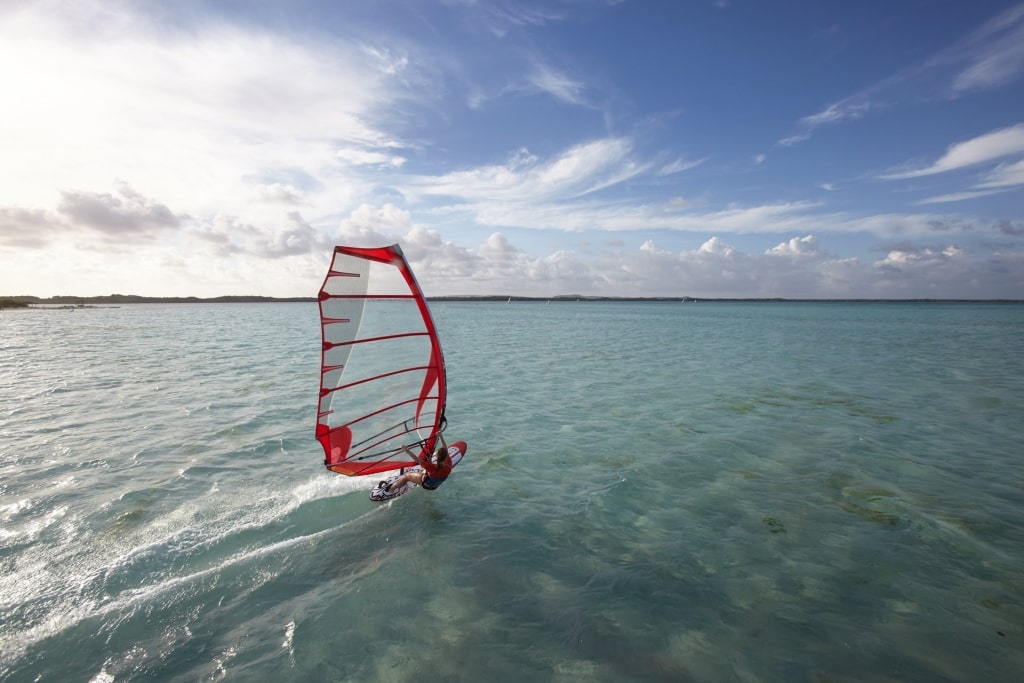
Lac Bay
Lac Bay is one of the most fun places on the island. Along the bay, you’ll find open-air bars and restaurants, most of which have benches and beach chairs arranged in the gentle surf. Take windsurfing lessons or rent a board and go out on your own in the shallow water.
Lac Bay has a few different spots to spend a few hours, but if you’re looking for the most laid-back option, visit Jibe City. You can learn to windsurf or windfoil, do some gentle paddling on a kayak or stand-up paddleboard, or spend the afternoon sipping a margarita in the surf.
Get the Perfect Shot of Bonaire’s National Bird
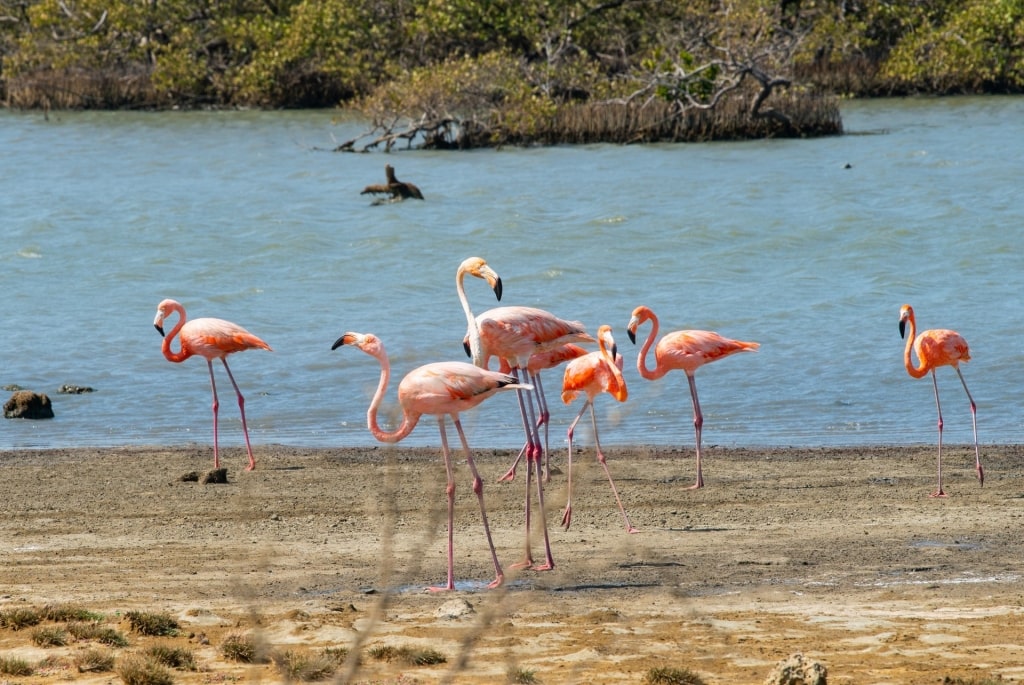
Gotomeer
If you’ve never seen a flamingo in the wild, make time to visit Gotomeer, a landlocked saltwater lagoon on the north part of the island. The lagoon is one of the few places in the world where Caribbean flamingos—generally considered the brightest flamingo in the world—come to nest and raise their babies. The flamingo is the island’s national bird, and there’s a dedicated viewing area where you can watch the elegant animals in the wild.
Explore the Area Around Rincon Village
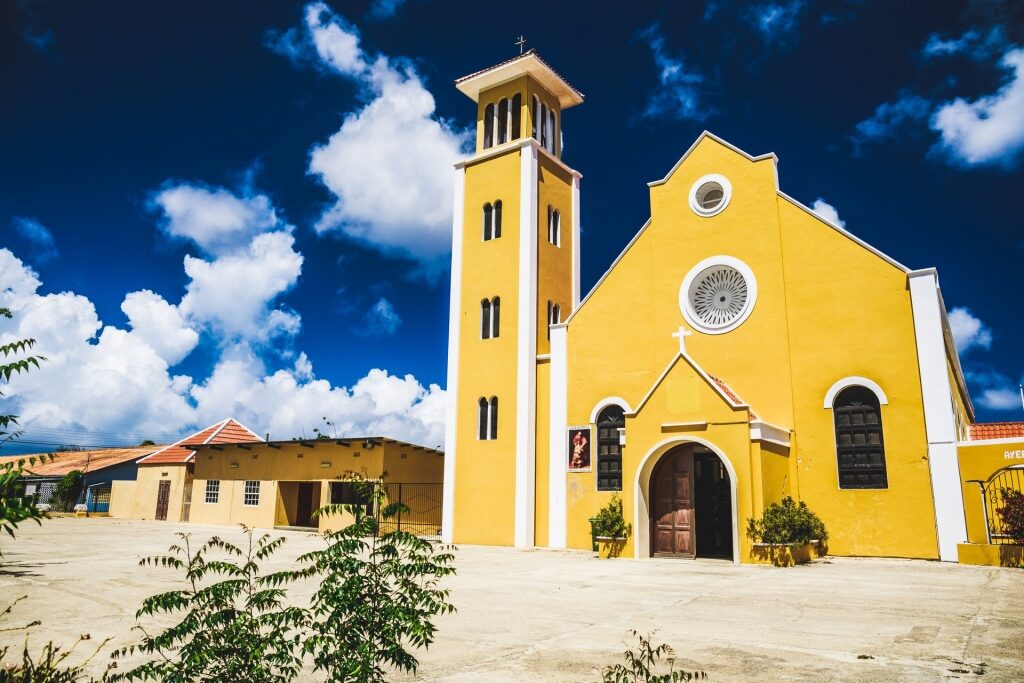
Rincon Church
Bonaire’s history runs deep, and there’s a lot to learn about the island. Around Rincón, which has been a town since the 1500s, there are plenty of things to do. Try a gentle hike through the cactus-covered landscapes and around unique rock formations, or book a tour of the Echo Dos Pos Bird Conservation Center.
If you need a break from the sun and want to check out one of the best things to do in Bonaire, book a tour that stops by the incredibly unique Cadushy Distillery. Cacti grow nearly everywhere on the island, and this distillery makes the world’s only cactus-based liquor. While you’re tasting their various concoctions, you may be able to spot wildlife like hummingbirds, colorful parrots, or one of the island’s famously large iguanas.
Ride Through the Island on an ATV
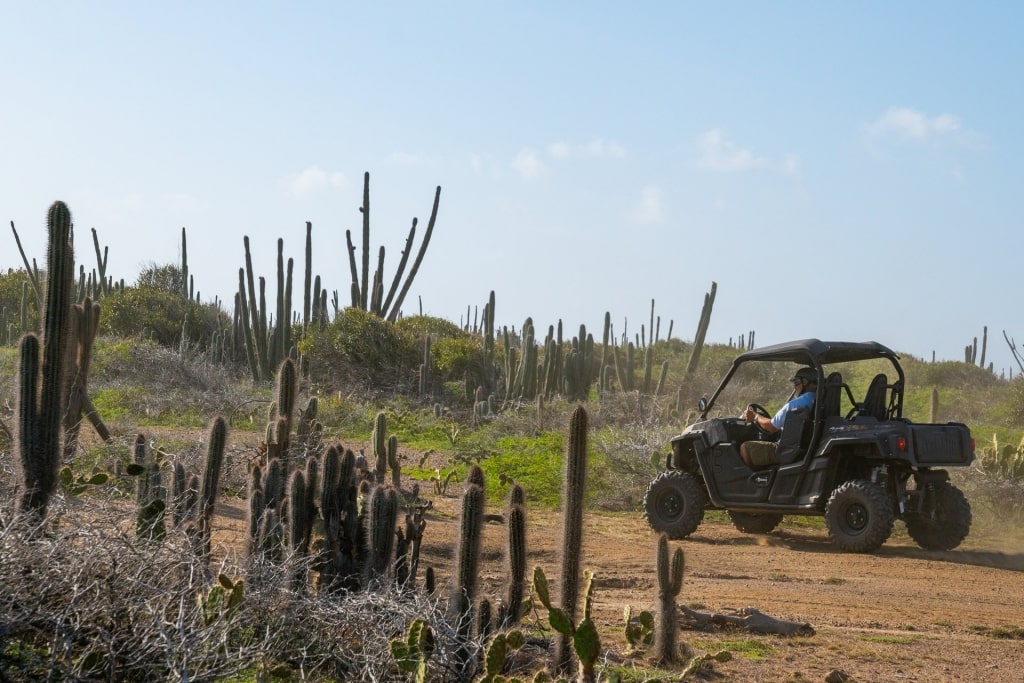
Washikemba Reservoir
Island life doesn’t have to be all about relaxing on the beach or gently floating in crystal-clear water. If you want to up the adventure factor, consider driving an ATV through Washikemba Reservoir. Drive through the reservoir, spotting wild donkeys and massive iguanas, and along some of the most picturesque coastal roads on the island.
Some ATV tours also stop at other locations, like hidden caves. Bonaire has more than 400 caves tucked into the island, many of which are large enough to explore.
Riding across the island on an ATV is a fantastic experience, especially as you’ll often be able to splash through mud and kick up sand on ocean-view roads lined with huge cacti. If you like action sports, you’ll definitely consider this one of the best Bonaire activities.
Sail on Land
Don’t worry if you’ve never heard of land sailing; you don’t need any knowledge of the sport to try it. Bonaire has one of the longest land sailing tracks in the world, and your knowledgeable guide will show you everything you need to know in around 10 minutes.
The “ships” are easy to steer, with just a small cart as the body, a simple steering wheel, and a huge sail. Bonaire’s trade winds are usually constant and gentle, making it an excellent place to catch a wave without any experience. The wind is relatively constant—after all, Bonaire is French for “good air” (or “good wind”)—so you can try the sport no matter what time of year you visit.
Take a Trolley Tour of the Capital
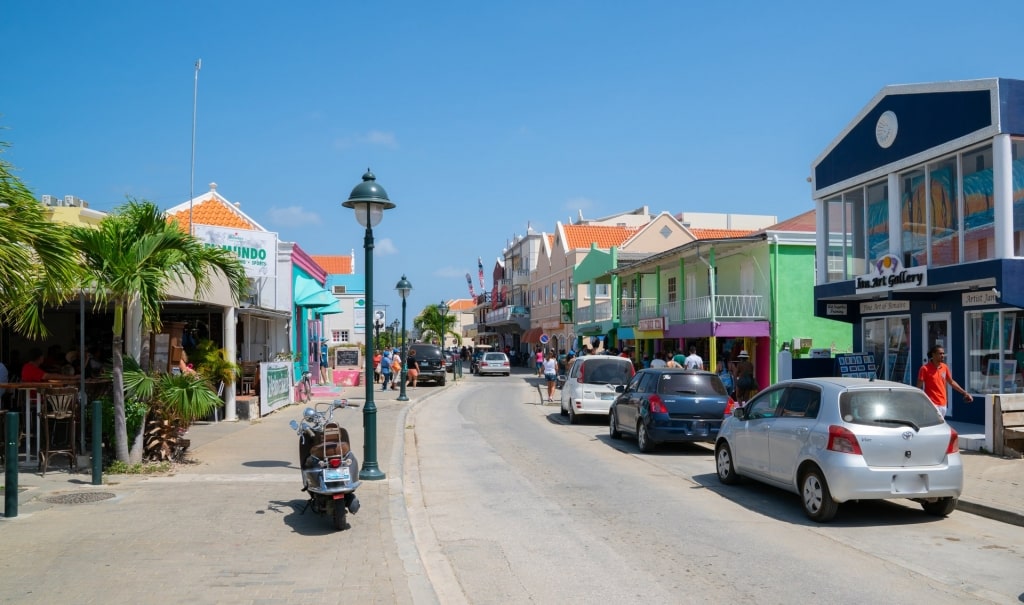
Kaya Grandi
First established in the mid-1600s, Kralendijk is the epitome of a tropical capital. With colorful architecture, skillful street art, unique shops and restaurants, and beaches just a stone’s throw away, you could spend a whole afternoon slowly meandering through the town.
On the tour, you’ll cruise by marinas full of bright white sailboats and learn about the history of the town as you drive by some of its most famous buildings. While in Kralendijk, be sure to visit the open-air Bonaire Arts and Crafts Market, where you can buy island-made products ranging from sea salt and bath products to art, clothing, jewelry, and home goods. The market is very close to the cruise docks, so it’s easy to wander your way back after finding the perfect souvenir.
Take a Ride on a Glass-Bottom Boat
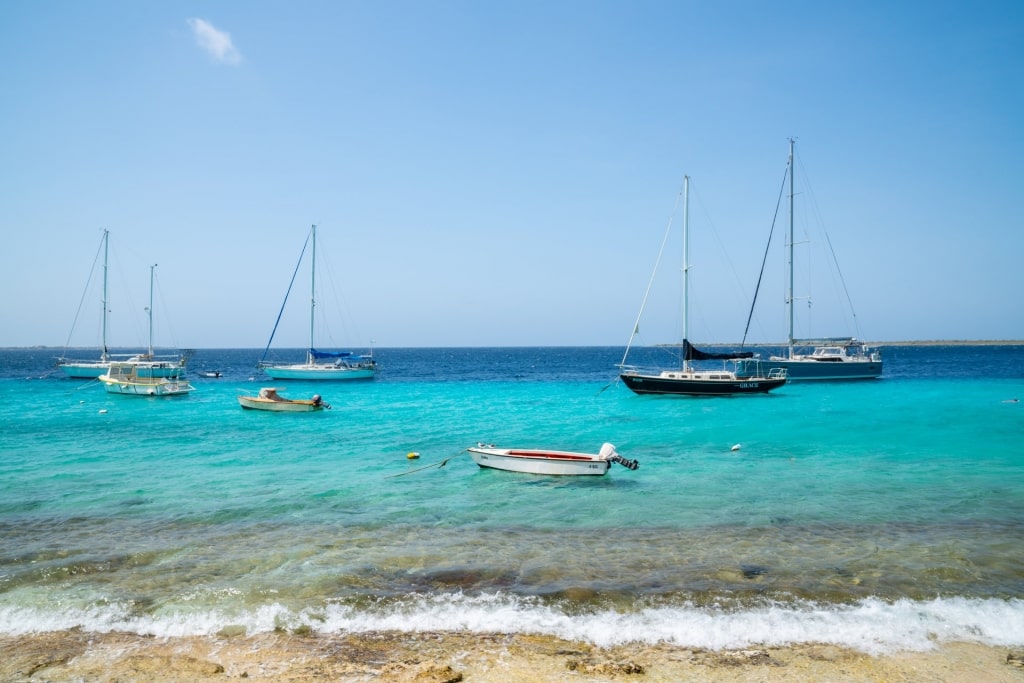
Bonaire
One of the most amazing things to do in Bonaire (actually, anywhere in the Caribbean!) is to take a trip on “Aquaspace,” one of the world’s most unique boats. On top, it’s a relaxing sailboat, where food and drink are served and there’s never a bad view.
From below, it’s a moving aquarium with a glass-bottom hull where you can sit below the surface of the water. Watching fish and other exotic creatures swim past you at eye level while you stay dry is an amazing experience, especially for kids, older travelers, or anyone who doesn’t have the fitness level for scuba diving.
Once you’ve had your fill of peering into the bright blue ocean (if that’s possible), head back up to the deck where there’s plenty of space to relax in the sun and enjoy the cool Caribbean trade winds. Aquaspace hosts brunch, sunset, and BBQ sails, and there’s usually an opportunity to snorkel off the boat in case you find yourself unable to resist diving in.
Explore Washington-Slagbaai National Park
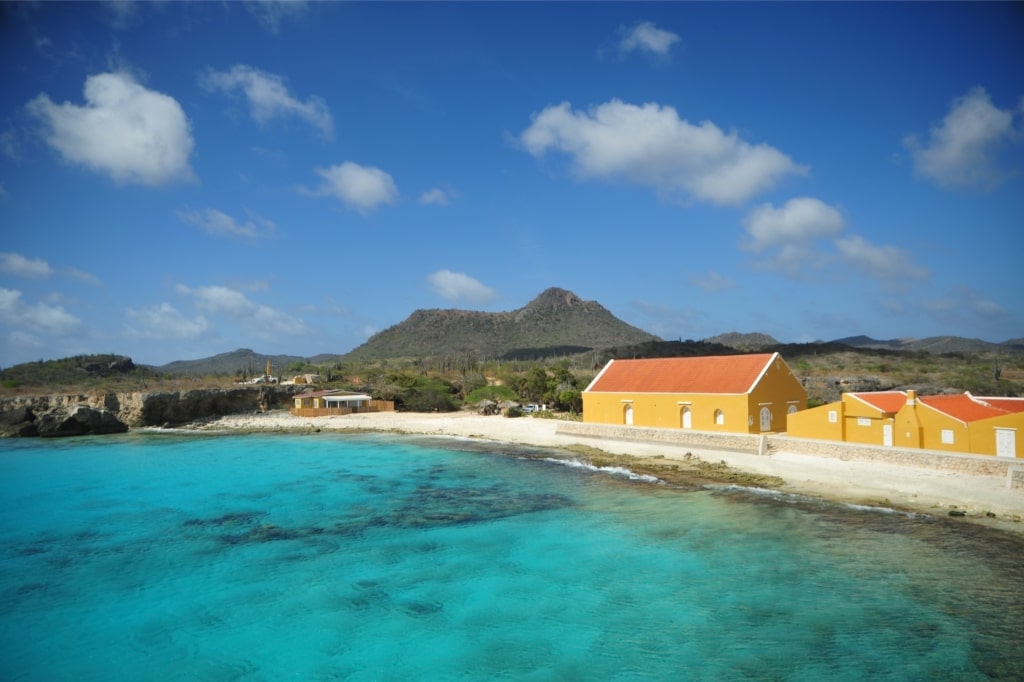
Washington-Slagbaai National Park
One of the best things to do in Bonaire is to embrace the island’s natural beauty. Almost 20 percent of Bonaire’s land area is protected as the Washington-Slagbaai National Park, a landscape of cactus-studded desert, scrub, salt pans, mangroves, and beautiful beaches. You’ll see flamingos feeding in the salt pans and iguanas basking under the sun here.
If you’re driving—and a 4×4 is recommended—follow one of the two signposted routes with stops for swimming and birdwatching; tropical mockingbirds and brown-crested flycatchers are a common sight in the park. Hikers will find two different marked trails, which will take from 90 minutes to two hours to complete, as well as a family-friendly trail.
There are no facilities beyond the restrooms at the entrance to the park, so bring everything you will need, including plenty of water.
Cool Off at Suplado Blow Hole
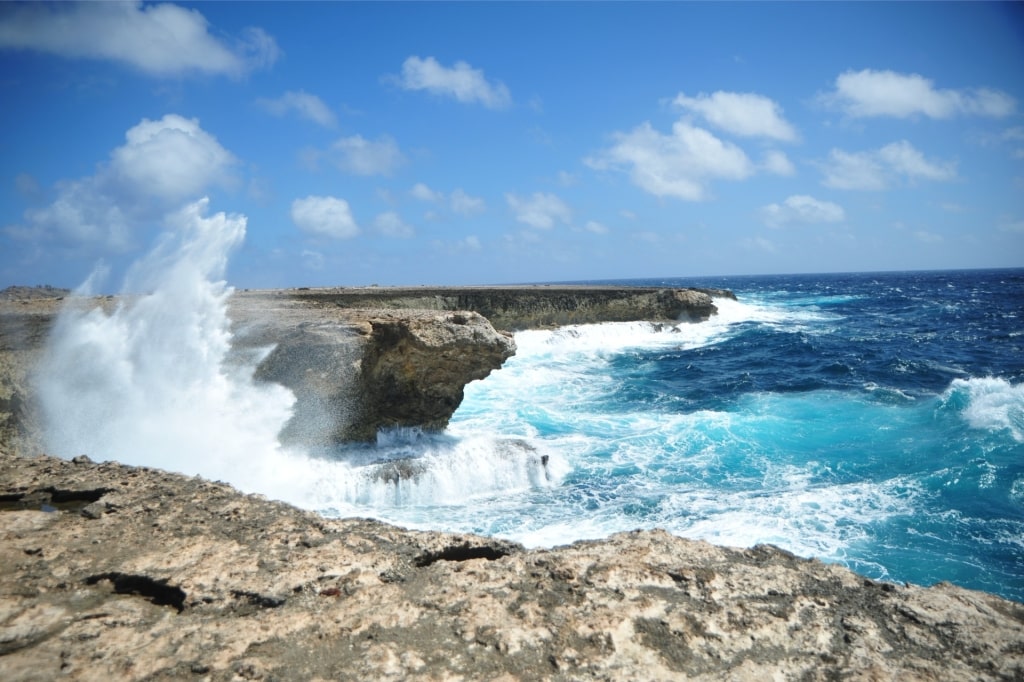
Suplado Blow Hole
One of the many geological features of Washington-Slagbaai National Park is the dramatic Suplado Blow Hole on the east coast. If you’re driving around the park, you can stop here and walk down to the coral rocks that fringe the wild shore.
The shape of the rocks and the power of the ocean mean that water is forced upwards when a wave slams into the shore, spurting out of a hole in the rock in a burst of spray, sometimes reaching several feet into the air. Have your camera ready and wait for your moment to snap the best shot.
Hikers can reach the blowhole by following the Lagadishi trail from the park entrance. If the conditions are right, standing near the hole is a great way to cool off with a refreshing shower of seawater.
Look Down on Kralendijk From Seru Largu
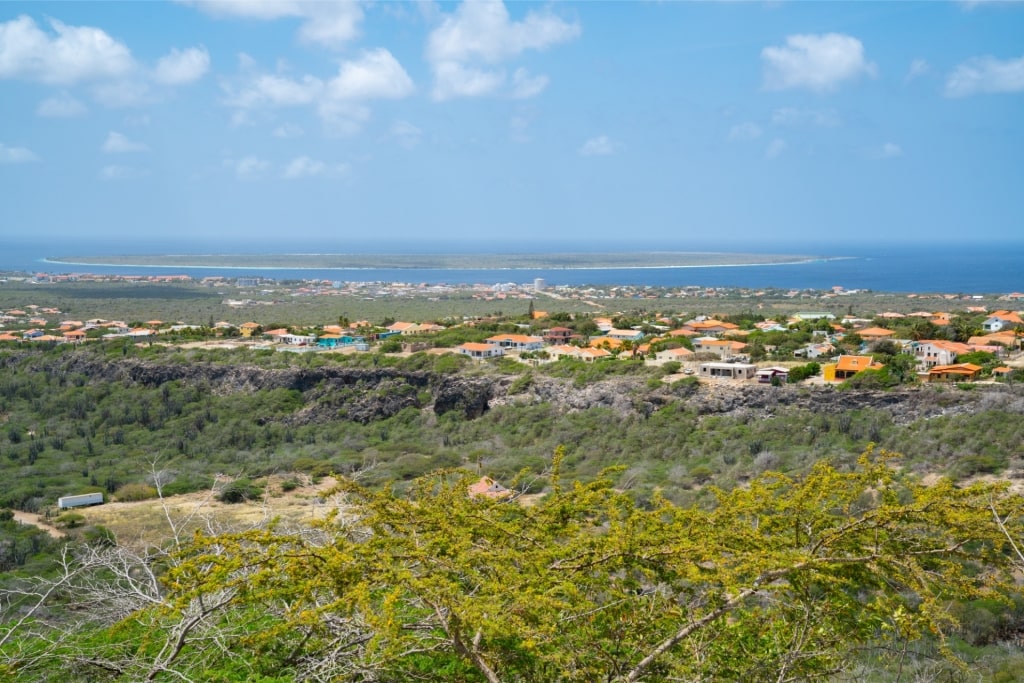
View from Seru Largu
While Bonaire is hilly rather than mountainous, and the south is relatively flat, it does have a good lookout point at Seru Largu, which means “large hill” in Papiamento, the local dialect. The hill, which lies to the north of Kralendijk, peaks at 400 feet and is an easy stroll if you want to stretch your legs.
The gentle ascent takes you through Brasilia trees and sage bushes, with iguanas and wild goats for company. At the top, you’ll be rewarded with sweeping views over Kralendijk and the desert-like Klein Bonaire island beyond. There’s a monument at the top in the island’s classic ochre and white colors, bearing the words “Kristu Ayera Awe Semper”, which translates as “Christ, Yesterday, Today, and Forever”.
Immerse Yourself in History at the Terramar Museum
Put your Bonaire experience into context at Kralendijk’s fascinating Terramar Museum. This compact museum takes you through 7,000 years of Caribbean history and offers displays of old documents and archaeological finds from around the Caribbean island.
The exhibits on the upper level tell the story of slavery on the island, a dark era of Bonaire’s history when enslaved people from Africa, as well as the original Caiquetios, were used as forced labor on plantations and salt pans.
Catch the Wind at Sorobon Beach
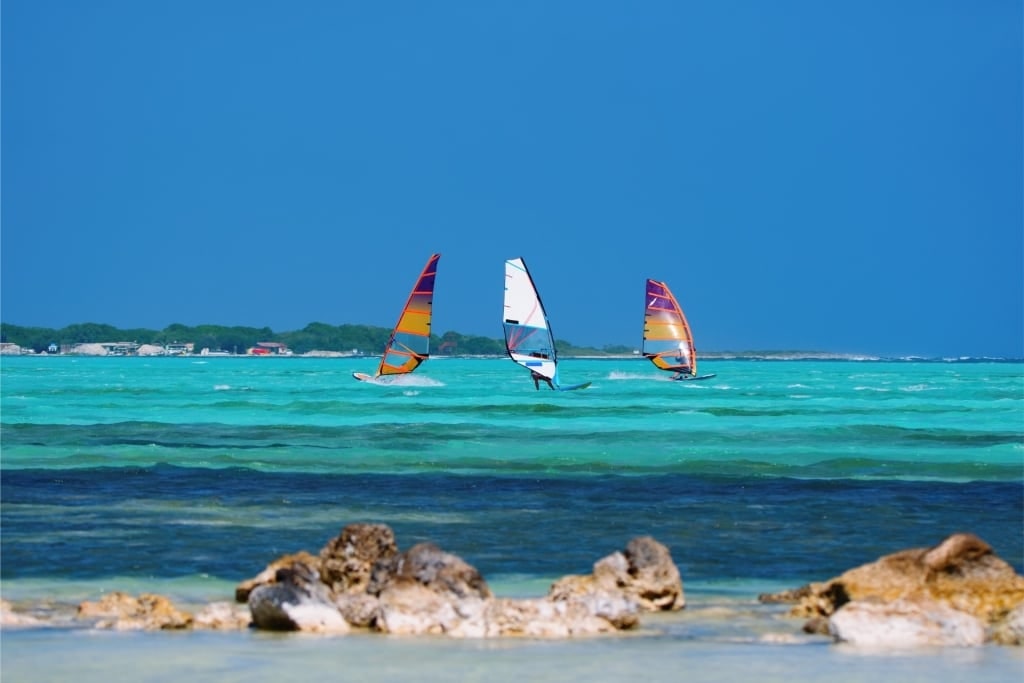
Sorobon Beach
Bonaire may be known for its diving and snorkeling, but Sorobon Beach is one of the best places in the Caribbean to learn to windsurf.
The beach is on the east side of the island, near Lac Bay, and is protected by a coral reef. It’s a glorious stretch of white sand, perfect for swimming and sunbathing, the pale turquoise shallows splotched with darker patches where sea grass grows.
The lengthy expanse of the beach and the clear, shallow water, together with steady trade winds, make this the perfect spot to try your hand at windsurfing. The conditions here are so good that multiple competitions, local and international, are held here.
Look for Turtles & Rays at 1,000 Steps Beach
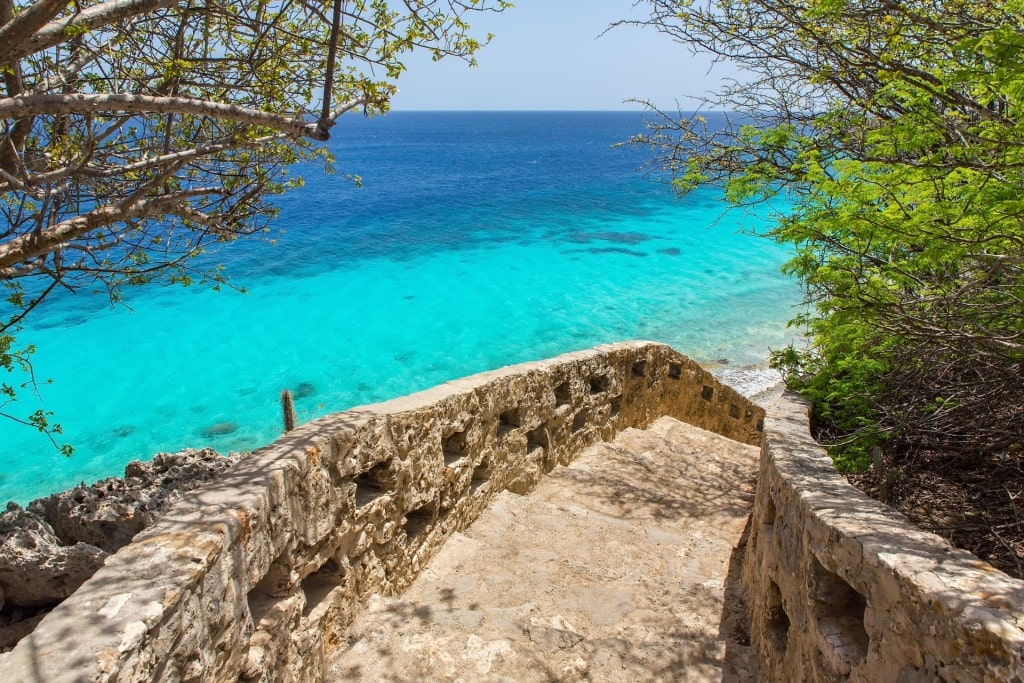
1,000 Steps Beach
This pretty beach, composed of bleached pieces of coral and white sand, backed by bottle-green shrubbery, lies on Bonaire’s west coast and is accessed via the Queen’s Highway. Mercifully, there are not 1,000 steps, but 67.
The name stems from the fact that for divers, this is a beach entry, so they have to carry their gear down the steps. The journey back up in the heat, some say, feels like 1,000 steps.
Even if you don’t dive, the snorkeling here is excellent thanks to tower-like corals that thrive in fairly shallow water. All manner of marine species live in and around the coral, including parrotfish, surgeon fish, and butterfly wrasse.
You could see turtles and even manta rays gliding through the blue—and if you’re really lucky, a mammoth whale shark. These gentle creatures are not dangerous; they are filter feeders and do not have any teeth.
Meet Local Donkeys
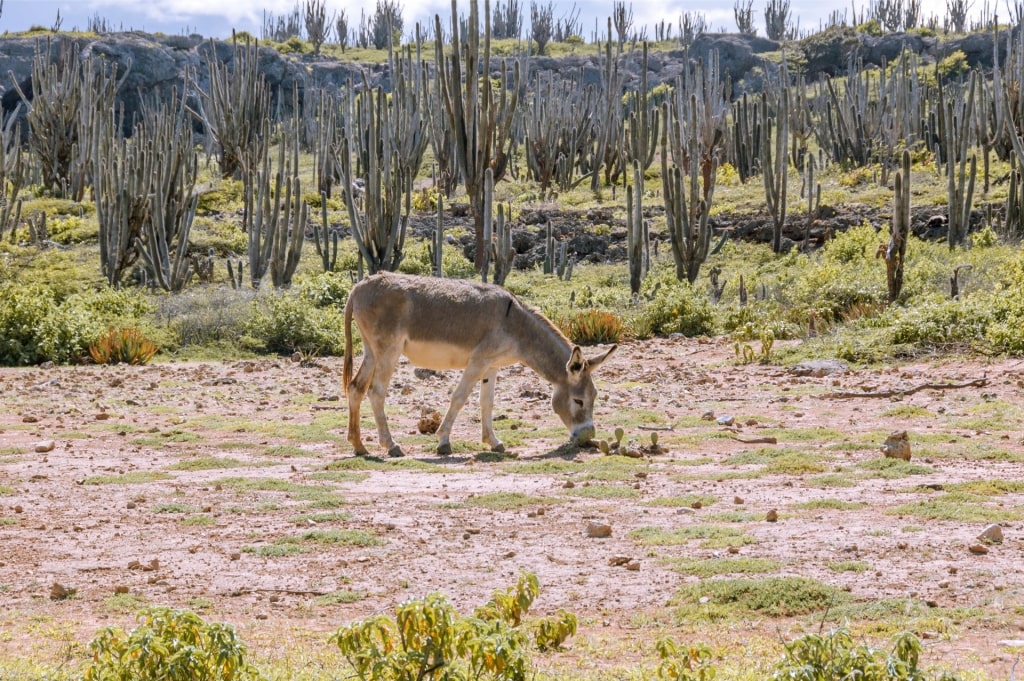
Donkey Sanctuary Bonaire
Donkeys were introduced to Bonaire by the Spanish in the 17th century as working animals to transport goods and humans. With the advent of motorized transport, the donkeys were redundant and were left to fend for themselves.
The Caribbean animals you see around Bonaire today are descendants of those original beasts of burden. There are around 1,100 wild donkeys on the island. Many see them as a symbol of Bonaire, but unfortunately, not all of the donkeys are in good condition. This is why the work of the Donkey Sanctuary Bonaire is so important.
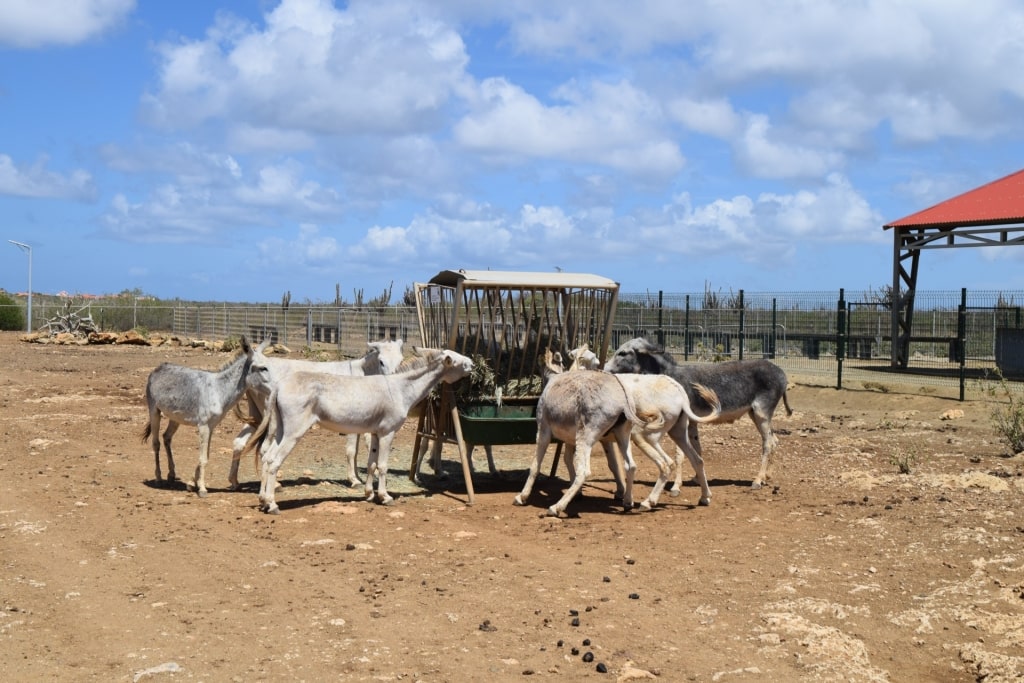
Donkey Sanctuary Bonaire
The sanctuary was set up in 1993 by a Dutch couple and today houses some 800 donkeys, all maintained by charitable donations. Some have been brought to the sanctuary sick or injured, while others are orphaned foals which have been hand-reared.
The donkeys, which are friendly and naturally curious, live in a large park, with a secure meadow for those with special needs. You can drive through the park and also enter the meadow on foot to feed the donkeys and get to know them.
Every entrance fee goes towards maintaining the sanctuary and its residents. There’s also a terrace café from which you can spot iguanas, tortoises, and often, flamingos. If you want some time away from the beach, a visit here is one of the best things to do in Bonaire.
Shop for Local Specialties
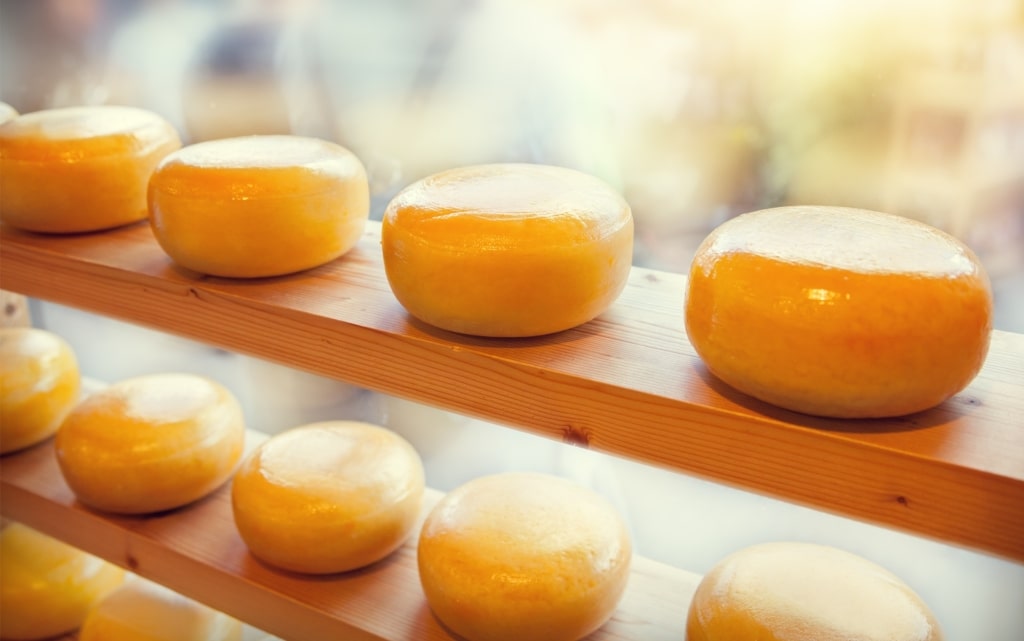
Dutch cheese
Kralendijk has some fun places to go shopping for local souvenirs and art, amid the many scuba diving shops. Stroll along pretty Kaya Grandi, the main street, its restored buildings a riot of color in hot pink, turquoise, sunshine yellow, and orange. You can snap some great photos here.
There are all sorts of local items to buy as souvenirs. Check out scented salt scrubs and bath products made from salt harvested on the island. You’ll find Dutch cheeses, of course, Bonaire being a special municipality of The Netherlands, as well as sea glass jewelry, local liqueurs including cactus vodka, and for something memorable, instant cactus soup mix.
You’ll find more great souvenirs, including paintings and driftwood sculptures, at the Arts and Crafts Cruise Market in Wilhelmina Park, down on the waterfront.
Spot Fish at Bari Reef
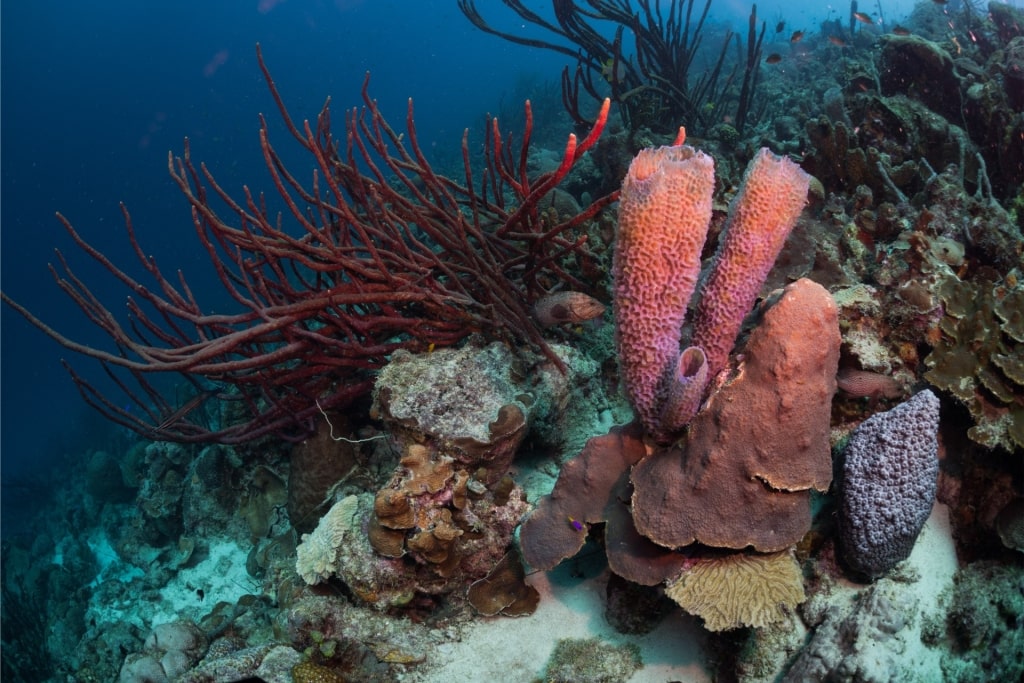
Bari Reef
If you’re looking for a snorkel spot close to Kralendijk, a day at Bari Reef is one of the best things to do in Bonaire. The diversity of marine life here is astonishing; more than 300 species have been logged at this site, from barracuda to octopus, tarpon, spiny lobster, and some more unusual creatures.
The pearly blue yellowhead jawfish carries its eggs in its mouth, for example, while the frogfish is an extraordinary-looking creature that would not do well in a fishy beauty contest.
You’ll see divers here entering the water from the beach. Snorkelers will have a great experience, too, drifting over the kaleidoscopic corals and yellow and scarlet sponges.
Learn About Parrot Conservation
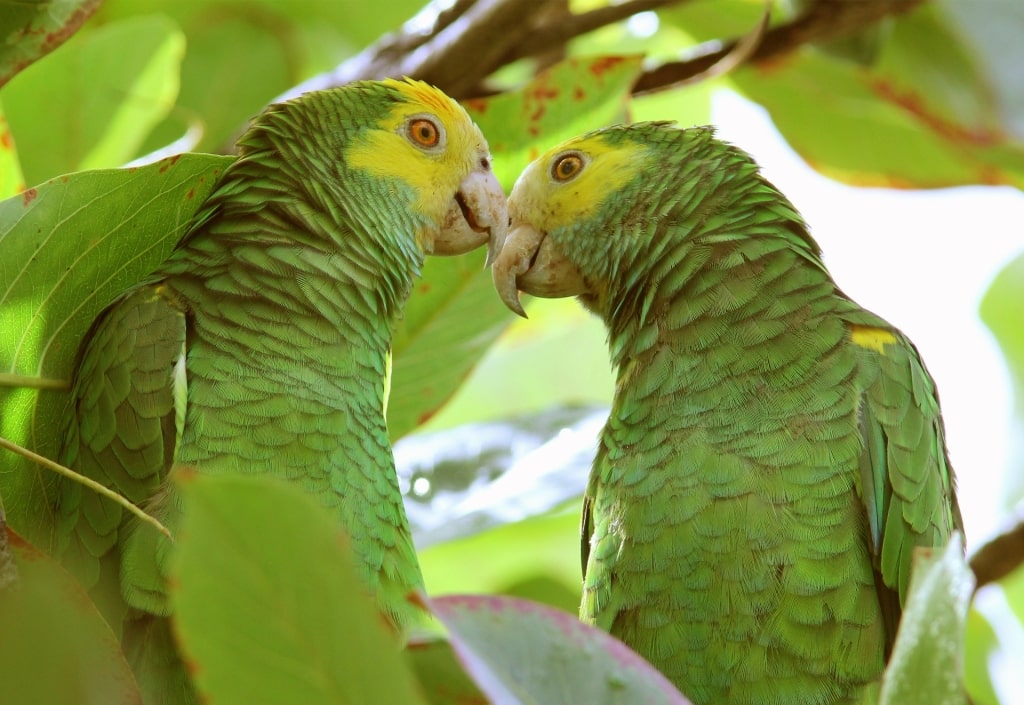
Yellow-shouldered amazon
The flamingo may be the national bird of Bonaire, but the yellow-shouldered Amazon parrot is a bird beloved by islanders. It’s only found here and in Venezuela and is considered endangered, with fewer than 1,000 individuals present on Bonaire.
You can see rescued and released parrots at Echo Dos Pos Conservation Centre, near Rincon. Walk through a replanted forest in the company of a naturalist, who will tell you about conservation efforts and help you to spot these charismatic birds.
Try a Taste of Bonaire

Kabritu stoba
Bonaire’s cuisine is influenced by the Caribbean, the Dutch, and the Spanish who colonized the island from 1499 for more than a century. You’ll find plenty of seafood on the menu, as well as recipes containing goat, a popular meat here. Many items come with a side of funchi, a cornmeal pudding not unlike polenta, and fried plantain.
A legacy of the Spanish is pastechis, similar to empanadas, which are pastries filled with chicken, fish, or meat, with local spices. If you like gumbo, you’ll love guiambo, a stew containing seafood and okra. Stobá is a slow-cooked, meaty stew; kabritu means it’s made from goat meat, and baku, beef.
For an island classic, try keshi yena, a hollowed-out Edam cheese packed with meat and baked. As the inside of the cheese melts, a rich flavor is absorbed by the meat.
See How Slaves Lived
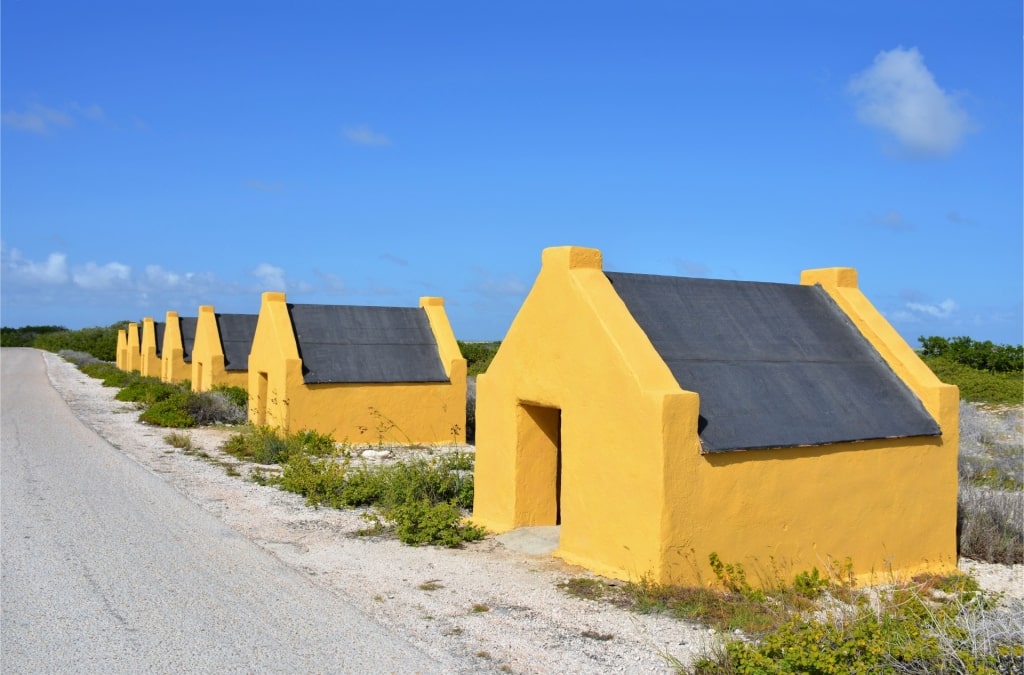
Slave huts
The old slave huts on Bonaire’s southern tip are a stark reminder of the brutality of the slavery era. The huts sit on the shore, in front of the Pekelmeer, where the island’s 18 salt pans are located.
Slaves from Africa were made to work the salt pans, but they lived in Rincon, in the center of the island. At the beginning and end of the week, they had to walk seven hours to and from the coast. During the week, they slept in the open air.
The coral stone huts were built by the West India Company in 1850 to overcome the problem of the long commute and the lack of shelter. They are tiny, less than five feet high, mostly with no windows. At times, up to six slaves were made to share one hut. Slavery was abolished in 1863, but the huts have been left standing as a stark memory.
You can see the huts in two locations on the Pekelmeer; there are ocher huts on the very southern tip of the island and white ones a little further up the west coast.
FAQs
Is Bonaire worth visiting?
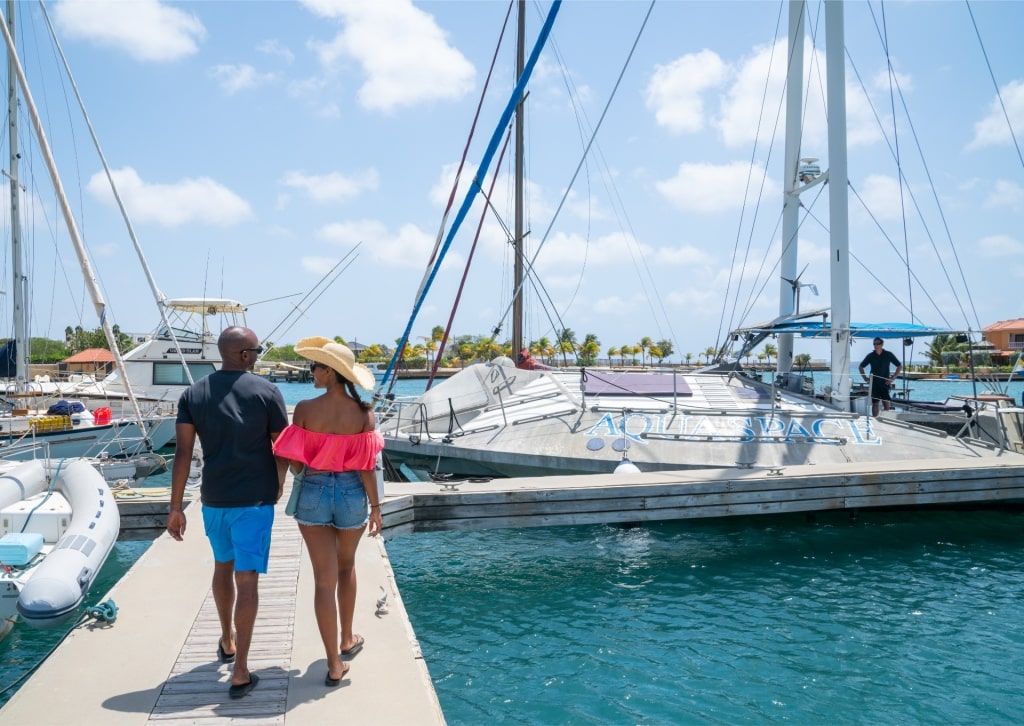
Bonaire
Yes, Bonaire is absolutely worth visiting. Compared to its more developed neighbors, Aruba and Curaçao, the island is sleepy and peaceful. People come here for the unrivaled diving, food scene, pristine beaches, and a taste of the authentic Southern Caribbean.
What is Bonaire most known for?
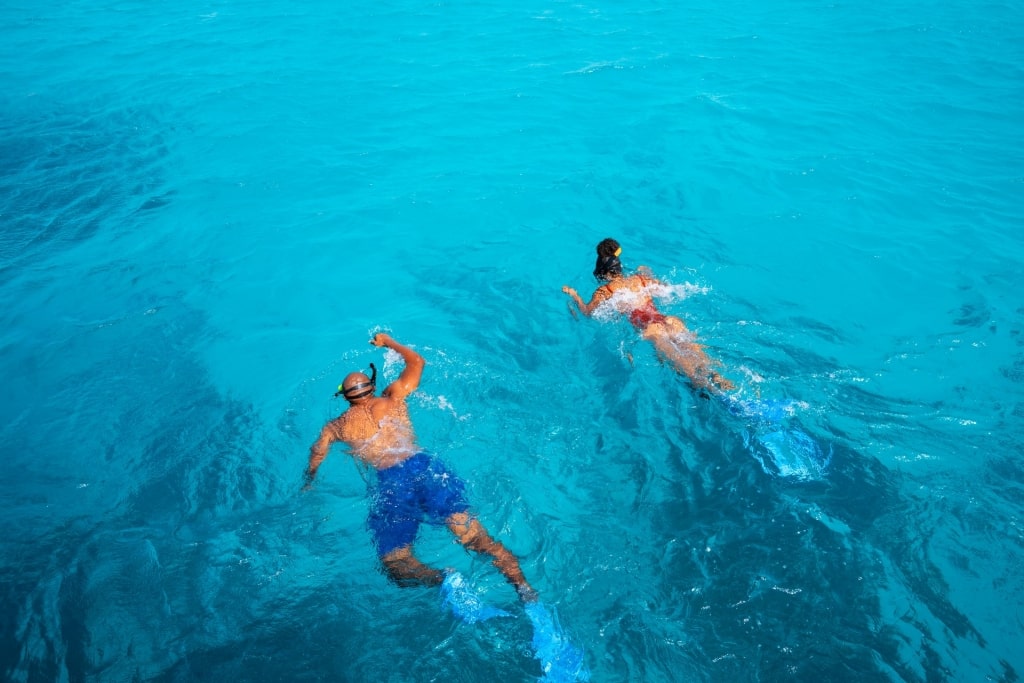
Snorkeling in Bonaire
Bonaire is most famous for its spectacular underwater world, with more than 85 official dive and snorkel sites around the island. The entire island is circled by the Bonaire National Marine Park and is seen as a shining example of conservation in action.
This tiny, underrated Caribbean island is also known for its Dutch heritage, which you’ll see in the colorful architecture, place names and dialect, and food. It’s famed for its wild donkeys, its flamingos, its fine cuisine, and its gorgeous beaches, too.
How do I get around Bonaire?
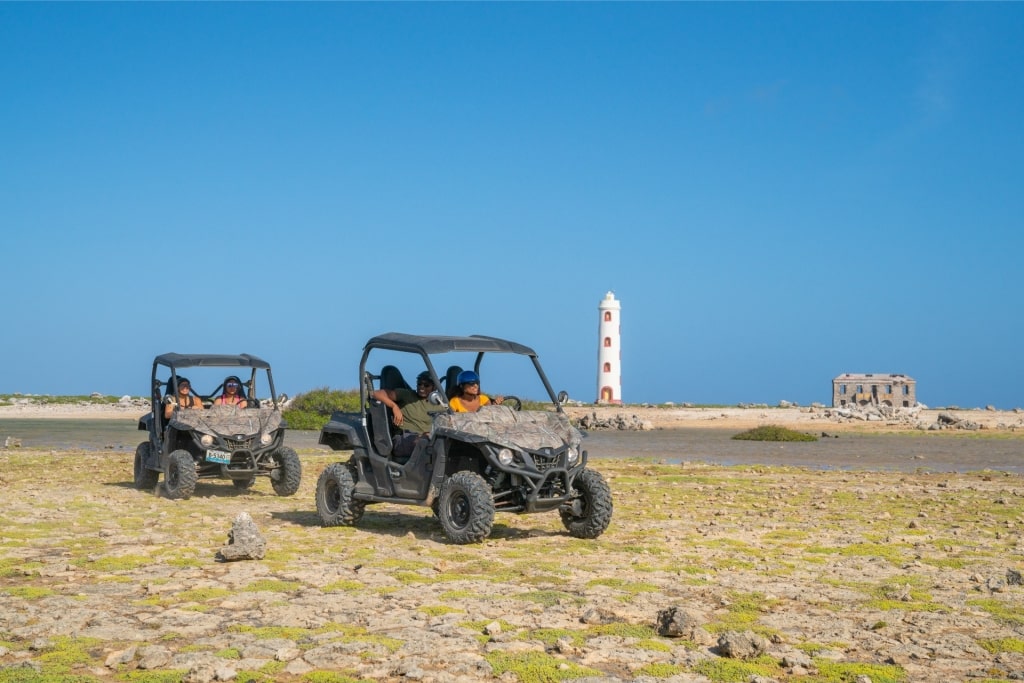
UTV ride
There is little public transport on Bonaire, but getting around the island under your own steam is easy. There are dozens of car rental companies, as well as places that rent motorcycles, scooters, mountain bikes, golf carts, and 4x4s.
Be aware that the off-road trails are rugged, and once you’re inside the big Washington-Slagbaai National Park, there are no facilities, so choose a mode of transport that matches your requirements. Also note that there are plenty of natural hazards on Bonaire, not least of all goats and donkeys in the roads.
If you prefer not to drive, there are taxis on the island that will take you to the various beaches. Make an agreement with the taxi driver to pick you up again at a pre-arranged time.
You can get to Klein Bonaire, which is only possible as a day trip, by ferry or water taxi from Kralendijk. The journey takes 20-25 minutes. And if you choose to spend your day in Kralendijk, it’s easy to walk everywhere.

Sailing in Bonaire
Discover this stunning island on a cruise to Bonaire. Choose from the carefully curated list of shore excursions and experience the best that this tropical paradise has to offer, all from the comfort of our cruise ships.
Browse cruise itineraries on our website and book your unforgettable vacation today.
